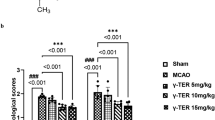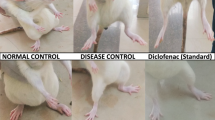Abstract
Hippophae salicifolia (HS) and Hippophae rhamnoides turkestanica (HRT) are abundantly found species of Hippophae in Himalayan region of India. As these plants thrive under extreme climatic conditions, it is suspected that these plants must have a unique adaptogenic property against high-altitude stress. To keeping these views in our mind, the present study was planned to evaluate the mechanism of action of aqueous extract of HS and aqueous extract of HRT against multiple stress [cold-hypoxia-restraint (C-H-R)] for their adaptogenic activity. The present study reported the adaptogenic activity of HS in facilitating tolerance to multiple stress, CHR in rats. Pre-treatment with aqueous extract of HS significantly attenuated reactive oxygen species (ROS) production, protein oxidation, and lipid peroxidation and also showed role in maintaining antioxidant status as similar to control rats. Since protein oxidation was decreased by pre-treatment of HS, protein homeostasis was also sustained by regulation of heat shock proteins (HSP70 and HSP60). Interestingly, heme oxygenase-1 (HO-1), Vascular Endothelial Growth Factor (VEGF), and nitric oxide (NO) level was also increased in HS pre-treated rats depicted its adaptogenic activity against multiple stress, CHR. Conclusively, aqueous extract of HS could use an adaptogen for high altitude-associated multiple stress (CHR).







Similar content being viewed by others
References
Anyasor GN, Ogunwenmo KO, Oyelana OA, Akpofunure BE (2010) Phytochemical constituents and antioxidant activities of aqueous and methanol stem extracts of Costus afer Ker Gawl. (Costaceae). Afr J Biotechnol 9:4880–4884
Askew EW (1995) Environmental and physical stress and nutrient requirements. Am J Clin Nutr 61:631S–637S
Askew EW (1997) Nutrition and performance in hot, cold, and high altitude environments. In: Wolinsky I (ed) Nutrition in exercise and sport, 3rd edn. CRC Press, Boca Raton, pp 597–619
Beckman RP, Mizzen LA, Welch WJ (1990) Interaction of HSP70 with newly synthesized proteins: implications for protein folding and assembly. Science 248:850–854
Beveridge T, Li TSC, Oomah BD, Smith A (1999) Seabuckthorn products: manufacture and composition. J Agric Food Chem 47:3480–3488
Blau HM, Banfi A (2001) The well-tempered vessel. Nat Med 7:532–534
Boucher JL, Moali C, Tenu JP (1999) Nitric oxide biosynthesis, nitric oxide synthase inhibitors and arginase competition for L-arginine utilization. Cell Mol Life Sci 55:1015–1028
Brero A, Ramella R, Fitou A, Dati C, Alloatti G, Gallo MP (2010) Neuregulin-1beta1 rapidly modulates nitric oxide synthesis and calcium handling in rat cardiomyocytes. Cardiovasc Res 88:443–452
Carmeliet P, Jain RK (2000) Angiogenesis in cancer and other diseases. Nature 407:249–257
Cathcart R, Schwiers E, Ames BN (1983) Detection of pico mole levels of hyderoperoxides using fluorescent dichlorofluoroscein assay. Anal Biochem 134:111–116
Chiang HL, Terlecky SR, Plant CP, Dice JF (1989) A role for a 70-kilodalton heat shock protein in lysosomal degradation of intracellular proteins. Science 246:382–385
Connolly DT (1991) Vascular permeability factor: a unique regulator of blood vessel function. J Cell Biochem 47(3):219–223
Connolly DT, Heuelman DM, Nelson R, Olander JV, Eppley BL, Delfino JJ, Siegel NR, Limgruber RM, Feder J (1989) Tumor vascular permeability factor stimulates endothelial cell growth and angiogenesis. J Clin Invest 84:1470–1478
Day AJ, Williamson G (2001) Biomarkers for exposure to dietary flavonoids: a review of the current evidence for identification of quercetin glycosides in plasma. Br J Nutr 86:S105–S110
Dong DL, Zhang Y, Lin DH, Chen J, Patschan S, Goligorsky MS, Nasjletti A, Yang BF, Wang WH (2007) Carbon monoxide stimulates the Ca2_ activated big conductance K channels in cultured human endothelial cells. Hypertension 50:643–651
Eccleston C, Baoru Y, Tahvonen R, Kallio H, Rimbach GH, Minihane AM (2002) Effects of an antioxidant-rich juice (sea-buckthorn) on risk factors for coronary heart disease in humans. J Nut Biochem 13:346–354
Fandrey J (2004) Oxygen-dependent and tissue-specific regulation of erythropoietin gene expression. Am J Physiol Regul Integr Comp Physiol 286(6):R977–R988
Forsythe JA, Jiang BH, Iyer NV, Agani F, Leung SW, Koos RD, Semenza GL (1996) Activation of vascular endothelial growth factor gene transcription by hypoxia-inducible factor 1. Mol Cell Biol 16(9):4604–4613
Geetha S, Sairam M, Mongia SS, Singh V, Ilavazhagan G, Sawhney RC (2003) Evaluation of antioxidant activity of leaf extract of sea-buckthorn (Hippophae rhamnoides L.) on chromium(VI) induced oxidative stress in albino rats. J Ethnopharmacol 87:247–251
Goyal AK, Basistha BC, Sen A, Middha SK (2011) Antioxidant profiling of Hippophae salicifolia growing in sacred forests of Sikkim, India. Funct Plant Biol 38:697–701
Hazel JR (1995) Thermal adaptation in biological membranes: is homeoviscous adaptation the explanation? Annu Rev Physiol 57:19–42
Hissin PJ, Hilf R (1973) A fluorometric method for the determination of oxidized and reduced glutathione in tissue. Anal Biochem 74:214–226
Hu B, Tomita M (2007) The Hsp70 chaperone system maintains high concentrations of active proteins and suppresses ATP consumption during heat shock. Syst Synth Biol 1(1):47–58
Hu B, Mayer MP, Tomita M (2006) Modeling HSP70-mediated protein folding. Biophys J 91(2):496–507
Hunt C, Morimoto RI (1985) Conserved features of eukaryotic hsp70 genes revealed by comparison with the nucleotide sequence of human hsp70. Proc Natl Acad Sci U S A 82:6455
Ilavazhagan G, Bansal A, Prasad D, Thomas P, Sharma SK, Kain AK, Kumar D, Selvamurthy W (2001) Effect of vitamin E supplementation on hypoxia-induced oxidative damage in male albino rats. Aviat Space Environ Med 72:899–903
Joanny P, Steinberg J, Robach P, Richalet JP, Gortan C, Gardette B, Jammes Y (2001) Operation Everest III (Comex’97): the effect of simulated sever hypobaric hypoxia on lipid peroxidation and antioxidant defence systems in human blood at rest and after maximal exercise. Resuscitation 49:307–314
Jung HJ, Yang MZ, Kwon KH, Yenari MA, Choi YJ, Lee WT (2010) Endogenous agmatine inhibits cerebral vascular matrix metalloproteinases expression by regulating activating transcription factor 3 and endothelial nitric oxide synthesis. Curr Neurovasc Res 7:201–212
Kakkar P, Das B, Viswanathan PN (1984) A modified spectrophotometric assay of superoxide dismutase. Indian J Biochem Biophys 21:130–132
Kostic DA, Mitic SS, Mitic MN, Zarubica AR, Velickovic JM, Dordevic AS, Randelovic SS (2010) Phenolic contents, antioxidant and antimicrobial activity of Papaver rhoeas L. extracts from southeast Serbia. J Med Plant Res 4:1727–1732
LeBel CP, Ischiropoulos H, Bondy SC (1992) Evaluation of the probe 2′,7′-dichlorofluorescein as an indicator of reactive oxygen species formation and oxidative stress. Chem Res Toxicol 5:227–231
Levett DZ, Fernandez BO, Riley HL, Martin DS, Mitchell K, Leckstrom CA, Ince C, Whipp BJ, Mythen MG, Montgomery HE, Grocott MP, Feelisch M (2011) The role of nitrogen oxides in human adaptation to hypoxia. Sci Rep 1:109. doi:10.1038/srep00109
Levine RL, Garland D, Oliver CN, Amici A, Climent I, Lenz A, Ahn B, Shaltiel S, Stadtman ER (1990) Determination of carbonyl content in oxidatively modified proteins. Methods Enzymol 186:464–478
Levine RL, Williams J, Stadtman ER, Shacter E (1994) Carbonyl assays for determination of oxidatively modified proteins. Methods Enzymol 233:346–57
Levy AP, Levy NS, Wegner S, Goldberg MA (1995) Transcriptional regulation of the rat vascular endothelial growth factor gene by hypoxia. J Biol Chem 270(22):13333–13340
Li H, Wang Z, Liu Y (2003) Review in the studies on tannins activity of cancer prevention and anticancer. Zhong Yao Cai 26:444–448
Lu R (1992) Seabuckthorn: a multipurpose plant species for fragile mountains. ICIMOD Occasional Paper No. 20, Kathmandou, Nepal; p 62
MacMillan-Crow LA, Crow JP, Thompson JA (1998) Peroxynitrite-mediated inactivation of manganese superoxide dismutase involves nitration and oxidation of critical tyrosine residues. Biochem 37:1613–1622
Mohanraj P, Merola AJ, Wright VP, Clanton TL (1998) Antioxidants protect rat diaphragmatic muscle function under hypoxic conditions. J Appl Physiol 84:1960–1966
Moncada S, Palmer RM, Higgs EA (1991) Nitric oxide: physiology, pathophysiology, and pharmacology. Pharmacol Rev 43(2):109–142
Morimoto RI (1998) Regulation of the heat shock transcriptional response: cross talk between a family of heat shock factors, molecular chaperones, and negative regulators. Genes Dev 12(24):3788–3796
Morimoto RI, Kline MP, Bimston DN, Cotto JJ (1997) The heat-shock response: regulation and function of heat-shock proteins and molecular chaperones. Essays Biochem 32:17–29
Negi PS, Chauhan AS, Sadia GA, Rohinishree YS, Ramteke RS (2005) Antioxidant and antibacterial activities of various sea-buckthorn (Hippophae rhamnoides L.) seed extracts. Food Chem 92:119–124
Ollinger R, Yamashita K, Bilban M, Erat A, Kogler P, Thomas M, Csizmadia E, Usheva A, Margreiter R, Bach FH (2007) Bilirubin and biliverdin treatment of atherosclerotic diseases. Cell Cycle 6:39–43
Onkawa H, Onishi N, Yagi K (1979) Assay for lipid peroxides in animal tissues by thiobarbituric acid reaction. Anal Biochem 95:351–358
Pant M, Lal A, Rani A (2014) Hippophae salcifolia D Don-A plant with multifarious benefits. Int J Pharm Pharm Sci 6(11):37–40
Paula FBA, Gouvea CMCP, Alfredo PP, Salgado I (2005) Protective action of a hexane crude extract of pterodon emarginatus fruits against oxidative and nitrosative stress induced by acute exercise in rats. BMC Complement Altern Med 5:17
Polla BS, Kantengwa S, Francois D, Salvioli S, Franceschi C, Marsac C (1996) Mitochondria are selective targets for the protective effects of heat shock against oxidative injury. Proc Natl Acad Sci 93:6458–6463
Radak Z, Asano K, Lee KC, Ohno H, Nakamura A, Nakamoto H, Goto S (1997) High altitude training increases reactive carbonyl derivatives but not lipid peroxidation in skeletal muscle of rats. Free Radic Biol Med 22:1109–1114
Ramachandran U, Divekar HM, Grover SK, Srivastava KK (1990) New experimental model for evaluation of adaptogenic products. J Ethnopharmacol 29:275–281
Ranjith A, Kumar SK, Venugopalan VV, Arumughan C, Sawhney RC, Singh V (2006) Fatty acids, tocols and carotenoids in pulp oil of three Sea Buckthron species (Hippophae rhamnoides, H. salicifolia, and H. tibetana) grown in the Indian Himalayas. JAOCS 83:359–364
Rongsen L (1992) Sea-buckthorn a multipurpose plant species for fragile mountain. ICIMOD Occasional paper no. 20. ICIMOD, Katmandu, Nepal
Setchell KD, Faughnan MS, Avades T, Zimmer-Nechemias L, Brown NM (2003) Comparing the pharmacokinetics of daidzein and genistein with the use of 13C-labeled tracers in premenopausal women. Am J Clin Nutr 77:411–419
Sharma P, Suryakumar G, Singh V, Misra K, Singh SB (2014) In vitro antioxidant profiling of seabuckthorn varieties and their adaptogenic response to high altitude-induced stress. Int J Biometeorol 58(8). doi:10.1007/s00484-014-0925-2
Singh V (2001) Seabuckthorn (Hippophae L.) A wonder plant of dry and temperate Himalayas. Department of Agro forestery and Environment, Himachal Pradesh Agriculture university, Palampur; p 1760-62
Sinha AK (1972) Colorimetric assay of catalase. Anal Biochem 47:389–394
Stadtman ER (1993) Oxidation of free amino acids and amino acid residues in proteins by radiolysis and by metal-catalyzed reactions. Annu Rev Biochem 62:797–821
Tenhunen R, Marver HS, Schmid R (1968) The enzymatic conversion of heme to bilirubin by microsomal heme oxygenase. Proc Natl Acad Sci 61:748–755
Wang R, Wu L (1997) The chemical modification of KCa channels by carbon monoxide in vascular smooth muscle cells. J Biol Chem 272:8222–8226
Wang R, Wang Z, Wu L, Hanna ST, Peterson-Wakeman R (2001) Reduced vasorelaxant effect of carbon monoxide in diabetes and the underlying mechanisms. Diabetes 50:166–174
Wink DA, Miranda KM, Espey MG, Pluta RM, Hewett SJ, Colton C, Vitek M, Feelisch M, Grisham MB (2001) Mechanisms of the antioxidant effects of nitric oxide. Antioxid Redox Signal 3(2):203–213
Witko-Sarsat V, Friedlander M, Capeillere-Blandin C, Nguyen-Khoa T, Nguyen AT, Zingraff J, Jungers P, Descamps-Latscha B (1996) Advanced oxidation protein products as a novel marker of oxidative stress in uremia. Kidney Int 49:1304–1313
Xing C (2003) Health protection and processing technology of seabuckthorn tea: In: Singh V editor. Seabuckthorn (Hippophae L.)-A multipurpose wonder plant, Indus Publishing Company; p 475–8
Xu L, Giffard RG (1997) HSP70 protects murine astrocytes from glucose deprivation injury. Neurosci Lett 224:9–12
Yamakura F, Taka H, Fujimura T, Murayama K (1998) Inactivation of human manganese-superoxide dismutase by peroxynitrite is caused by exclusive nitration of tyrosine 34 to 3-nitrotyrosine. J Biol Chem 273:14085–14089
Yoshida T, Maulik N, Ho YS, Alam J, Das DK (2001) Hmox-1 constitutes an adaptive response to effect antioxidant cardioprotection. Circulation 103:1695–1701
Acknowledgments
Authors thank Dr. Shashi Bala Singh, Director of the Establishment for her support and encouragement.
Conflict of interest
The authors have declared that no competing interests exist.
Author information
Authors and Affiliations
Corresponding author
Rights and permissions
About this article
Cite this article
Rathor, R., Sharma, P., Suryakumar, G. et al. A pharmacological investigation of Hippophae salicifolia (HS) and Hippophae rhamnoides turkestanica (HRT) against multiple stress (C-H-R): an experimental study using rat model. Cell Stress and Chaperones 20, 821–831 (2015). https://doi.org/10.1007/s12192-015-0603-2
Received:
Revised:
Accepted:
Published:
Issue Date:
DOI: https://doi.org/10.1007/s12192-015-0603-2




